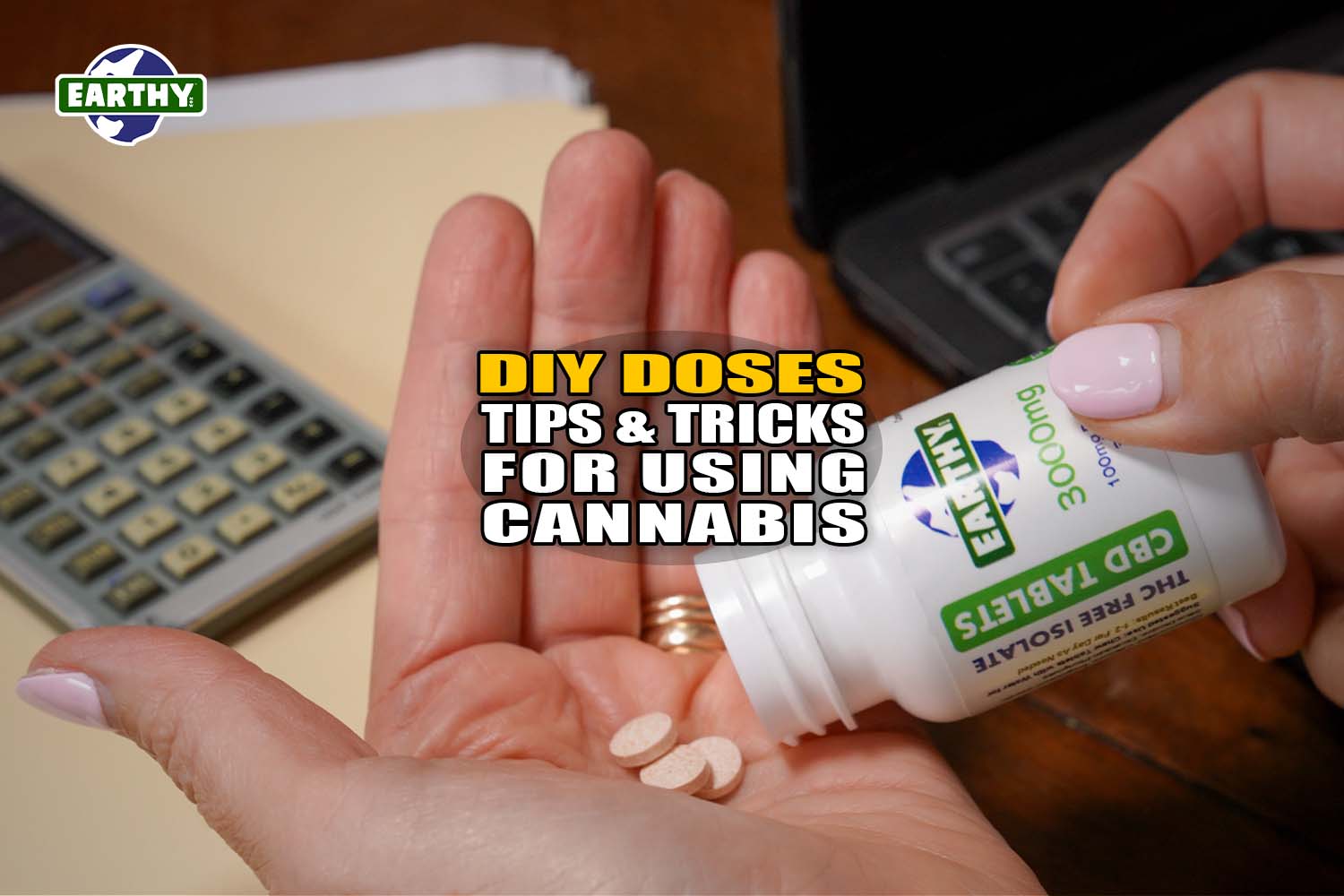Cannabis use has evolved significantly over the past few decades, with increasing recognition of its potential wellness benefits and a growing body of research into its potential health effects. However consumers need to understand proper dosing, whether they’re using cannabis for medical purposes, recreational enjoyment, or just exploring its benefits. In this guide, we’ll dive into the art of DIY cannabis dosing, offering practical tips and tricks to help you personalize your cannabis use to meet your unique needs.
Understanding the cannabis plant and its components
The cannabis plant, also known as Cannabis sativa, and Cannabis indica, both from the family Cannabaceae, contains a variety of compounds that contribute to its effects. The most well-known are THC (tetrahydrocannabinol) and CBD (cannabidiol), both of which have distinct impacts on the body. THC is the compound responsible for the psychoactive effects often associated with “getting high,” while CBD is known for its wellness benefits without psychoactive effects [1].
When using cannabis, it’s important to understand how these components interact. For example, the body rapidly absorbs THC, with effects activating within minutes when smoked. In contrast, it can take longer to feel the effects when an individual consumes CBD in weed pills, edibles, or liquid weed (tinctures). On the other hand, CBD is not psychoactive, and many people use it for wellness purposes without the “high” associated with THC [2].
Understanding THC and CBD: The Key Components of Cannabis
Why DIY dosing?
The idea of DIY dosing is appealing for many reasons. Whether you’re smoking cannabis or making your own edibles, DIY dosing allows you to customize your experience. Also, this level of control can be particularly useful if you’re using cannabis to ease symptoms of specific conditions. Though the debate continues over how cannabis might or might not help conditions like nausea and vomiting, eating disorders, or multiple sclerosis – many people report relief from various discomforts [3].
Moreover, cannabis laws vary widely depending on your location, and medical marijuana may not always be accessible [4]. For some people, creating their own cannabis products offers a more cost-effective solution than purchasing commercial options.
In addition to cost and accessibility, DIY dosing may benefit those concerned about certain health effects of cannabis. In other words, while many people enjoy smoking cannabis, inhaling marijuana or hemp smoke carries risks similar to tobacco smoke. Indeed, smoking of any kind can affect lung health [5]. For this reason, many people prefer alternative consumption methods such as edibles, tinctures, or vaporizers. These offer a smoke-free experience and may reduce the risk of respiratory problems [6].
How to Choose the Right Gummies for You
Tips for safe and effective dosing when using cannabis
Start low and go slow
When you’re experimenting with cannabis, whether for the first time or with new products, it’s essential to follow the mantra: “Start low, go slow.” Notably, the cannabis plant has varying effects on different individuals. Also, the consumption method influences effects. For instance, when you smoke cannabis, the body absorbs THC rapidly, and most individuals experience the effects almost immediately. In contrast, the onset can take up to two hours with edibles. As a result, it’s easy to consume more THC than you intended accidentally [2].
Understand consumption methods
Cannabis comes in different forms, each with its own unique properties. Typically, smoking the flower is the fastest way to feel the effects. Yet, smoking may cause the same breathing problems and lung issues as tobacco smoke. Thus, for those looking to avoid these risks, hemp or marijuana products like edibles or vaporized cannabis may be better options [2].
- Smoking marijuana or hemp: Rapid effects but carries risks associated with marijuana smoke.
- Edibles and tinctures: Slower onset but longer-lasting effects, which can make dosing tricky [2].
- Topicals: For localized effects, without systemic effects [7].
Keep a journal
Tracking your cannabis use can help you fine-tune your doses over time. Indeed, some people find that keeping notes on the effects of cannabis, the dose, the consumption method, and any potential adverse effects makes tracking easier. This information may be particularly helpful if you’re using cannabis to uplift mood [8]. However, cannabis may exacerbate a mental health condition, such as bipolar disorder or severe forms of anxiety. Thus, if you have an acute mental health condition or any questions, you should consult a healthcare professional before using cannabis [9].
Avoid the Cross-Faded Effect: The Relationship Between Cannabis and Alcohol
Use measured tools
For accurate dosing, it’s important to use tools like scales, droppers, and syringes. For example, if you make your own edibles, you’ll need to calculate how much THC or CBD is in each serving to avoid high doses [10]. Keep in mind that high, chronic doses can lead to nausea and vomiting, altered sense of reality, or even cannabis use disorder [11].
DIY edibles: infusion and dosing
Making your own edibles allows you to control the potency and ensure you’re getting the right amount of THC or CBD for your needs. However, the process can be a bit tricky, especially when it comes to decarboxylation – the process of heating the cannabis to activate THC and CBD. Without this step, your edibles may not have the desired effects [10].
Once you’ve decarboxylated the cannabis, you can infuse it into butter or oil, which you can use in recipes. However, infusion ratios are key here: depending on the strength of your starting material, you’ll need to adjust the amount of cannabis to control the dose [12].
- Potency estimation: Always calculate the cannabinoid content of each serving, especially in homemade edibles, to avoid consuming high doses unknowingly [12].
- Body absorption: Remember that when you consume cannabis orally, it takes longer for the body to absorb cannabinoids, and the effects can last much longer than smoking [2].
The Best Low-THC Gummies on the Market
Tinctures and oils: easy DIY options
For those looking for quick and easy DIY cannabis products, tinctures are a great option. For example, by infusing cannabis into alcohol or oil, you can create a liquid weed solution that you can take sublingually (under the tongue).
With tinctures, dosing can be easier to control, as each drop can be measured precisely. Though some people use these tinctures with the intention of easing symptoms of certain conditions like neuropathic pain, multiple sclerosis, or chemotherapy-induced nausea, these outcomes have not been proven [13, 3]. Only a handful of cannabis-derived medications have been approved by the FDA [14]. Therefore, individuals looking to treat various health conditions should consult a physician for individualized treatment.
10 Great Wholesale Hemp Shopping Tips

Premium hemp-derived CBD products from Earthy Now
For cannabis consumers seeking reliable, trustworthy sources of federally compliant cannabis products, Earthy Now has something for everyone. These products reflect the industry’s cleanest and strongest ideals, with only trace amounts of Delta-9 THC.
Explore these natural products from Earthy Now, with organic ingredients, delivered discretely to your door:
- CBD Flower
- Gummies
- Lozenges
- Tablets (THC Free!)
- Soothing Relief Lotion
- Soothing Relief Salve
- CBD Pet Tinctures (no THC!)
- Oils
- Pre-Rolls
- Smokes
- Terpenes
Common dosing mistakes to avoid
When it comes to dosing, even experienced cannabis users can fall into common pitfalls. These include:
- Overconsumption: One of the biggest risks is taking too much too quickly. Thus, always wait at least two hours before increasing your dose [6].
- Not decarboxylating: If you skip this step, your edibles won’t be potent [10].
- Ignoring tolerance: Everyone’s tolerance is different, and it can also vary depending on how frequently you use cannabis. In other words, be mindful of your personal limits to avoid abuse or developing a substance use disorder [15].
Health considerations and risks associated with using cannabis
While many people think of cannabis as a source of wellness, it’s important to understand the potential risks. For example, recent research suggests that heavy, long-term marijuana use, especially in high-potency forms, may increase the risk of expressing a mental health condition like bipolar disorder or worsening symptoms of mental illness [9]. Also, early exposure to cannabis, particularly in young adults, may affect brain development problems and lower birth weight in infants born to mothers who use cannabis during pregnancy [16, 17].
Also, the risks of cannabis use comes with some long-term health concerns. For instance, like tobacco, smoking cannabis can increase the risks of lung cancer and other respiratory issues, including secondhand smoke exposure [2]. Additionally, withdrawal symptoms can occur in heavy users, similar to those experienced when ceasing to use dependence inducing drugs [18].
Key takeaway: tips and information about using cannabis
DIY dosing offers an opportunity to take control of your cannabis experience, whether you’re using it for wellness or recreational purposes. By understanding the effects of cannabis, starting with low doses and experimenting with different consumption methods, you can tailor your experience to suit your needs. Remember, always be mindful of the potential health effects and seek guidance from healthcare professionals. This is particularly crucial if you use cannabis to manage serious conditions or in conjunction with prescription medication [9].
As research suggests, cannabis can offer many benefits. Yet, we need more clinical trials and data to fully understand its long-term effects. For now, staying informed and dosing carefully is key to enjoying cannabis safely and effectively.
Visit Earthy Now for an amazing selection of high-CBD and low-THC products to suit every taste!
Medical Disclaimer / Legal Disclaimer – Information is provided for educational purposes. It does not and is not intended to constitute legal advice or medical advice. We attempt to be accurate and up-to-date, but the legality of cannabinoids and the science of cannabis are evolving. The author is neither a legal professional nor a medical expert. Before buying or using any products, you should check with your local authorities and medical providers.
References
- CBD vs. THC: What’s the Difference?
- Edible Cannabis vs Smoking Weed
- Therapeutic Effects of Cannabis and Cannabinoids
- Legality of Cannabis
- What Are the Long-Term Effects of Smoked Marijuana on Lung Health?
- Edibles: Types and How to Use Them Safely
- Topical Cannabidiol (CBD) in Skin Pathology
- Cannabis Journaling as a Wellness Practice
- Cannabis and Mental Health
- How to Make Cannabis Edibles for Sale or Personal Use
- 8 Side Effects of Cannabis (Weed) You Should Be Aware Of
- A Complete Step-By-Step Guide to Infusing Edibles
- Safety of Medical Cannabis in Neuropathic Chronic Pain Management
- Cannabis (Marijuana) and Cannabinoids: What You Need To Know
- How to Avoid a High Tolerance to Cannabis
- Effects of Cannabis on the Adolescent Brain
- Marijuana Use During Pregnancy Linked to Low Birth Weight
- Weed Withdrawal





